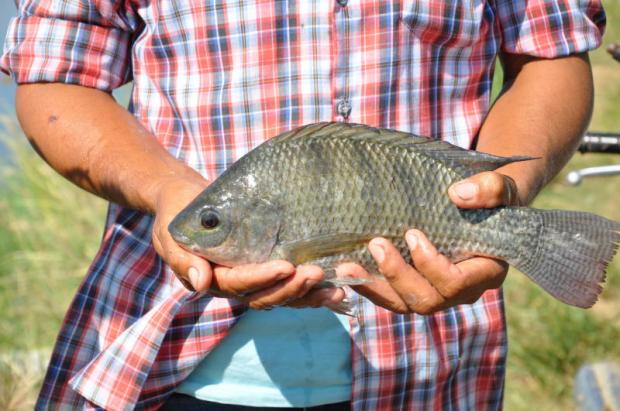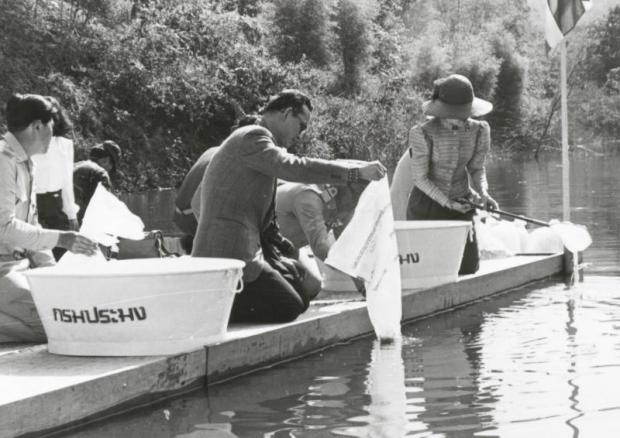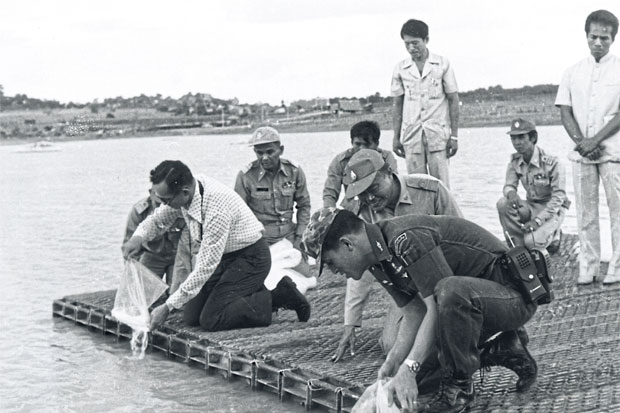Most, if not all, Thais do not know the Tilapia nilotica by its full-fledged name. But most, if not all, have probably eaten it before.
It's one of the most eaten freshwater fish in Thailand with 220,000 tonnes produced for the local market per year, according to the Department of Fisheries. It's seen regularly on the dishes of your average Thai households and restaurants. It's also the fish, that nearly seven decades ago, helped villagers in rural areas avoid starvation and malnutrition, and today it's helping agriculturalists and farmers make a living. This swiss-army-knife of a fish is actually the humble pla nil.
Unsurprisingly, it was King Bhumibol Adulyadej that introduced the species to Thailand in 1966, hoping to provide protein and nutrients to villagers in rural areas. However, he had been researching and experimenting about the tilapia species' biology and breeding habits since 1951 -- the first species being the Tilapia mosambica, or pla mo thet in Thai.
"Why did he choose the pla mo thet? Because local fish -- like local carp, or pla tapian, would only reproduce once a year," explained Supawat Komolmarl, director of the Royal Fisheries Initiated Project Division of the Department of Fisheries. "But the tilapia species would give birth every three months."
Tilapia also is easy to raise as they are mouthbrooders -- meaning that the female fish incubate their eggs in their mouth. Once the eggs develop into young fish, she lets them go, and in six months time, they'll be a good size to eat or sell. They additionally grow ideally in closed fresh water systems like aquacultures or rice fields. So it was King Bhumibol's idea that the fish could be raised in rice fields during plantation season, so farmers and their families could have the full nutrients they need.
"Before, villagers and farmers were poor and had nothing to eat," said Supawat. "And the Department of Fisheries at the time taxed people for fishing. It was a form of conservation, so to speak, so people wouldn't fish illegally. So the fastest way for villagers to have food to eat was introducing them to the pla mo thet."
In 1965, King Rama IX was presented with 50 superior tilapia species -- the Tilapia nilotica, from Japan's Crown Prince Akihito, later to become the Emperor of Japan. The late King bred the fish at the Chitralada Palace for a year, and bestowed it the name pla nil -- short for its scientific name.
"He donated 10,000 fingerlings to the Department of Fisheries in order to expand and distribute to people around the country," said Supawat.
Thanks to the push of the late monarch, the Department of Fisheries was also able to develop technology in order to mass produce the Tilapia nilotica for fish farming.
"In order to mass produce the fish, we can't wait for them to let go of their fingerlings from their mouth. So what we do is remove the eggs from their mouth, and nurse them inside a tray which mimics the current inside the mouth of the mother," explained Supawat. Being able to nurse the fish eggs with technology avoids mutations or premature loss of life that tends to happen when the fish are incubating the eggs themselves. Now, around 220,000 tonnes of pla nil are produced per year by 300,000 farmers countrywide thanks to this technology.
Fish farmer Pornchai Buapradit, 46, who raises pla nil along with shrimp in Chon Buri province, is one of the people who benefited greatly from this project.
"I've worked with pla nil for around 30 to 40 years, but I only started getting serious about raising them around 15 years ago," he said. In the past, pla nil was simply present in his aquacultures, consumed by him and his family.
"Before, I liked to farm tiger shrimp," he said. "Within the pond there would be pla nil as well. As time passed tiger shrimp became harder to raise, so I kept changing farming methods. I changed from tiger shrimp to whiteleg shrimp, but the fish would still be living in the pond. I didn't take notice of it before, since their prices weren't that great."
But in around 2003, Pornchai and a farmer's association he founded discussed numerous agricultural and fishing issues they've come to face. Seeing that Westerners prefer white-meat fish, that cold-storage owners were able to buy fish to freeze, and calculating that a rai of pla nil raised would give around a 10,000 baht profit per cycle, or around six months, he thought he would give it a try.
"We admitted that the fish was so cheap," he said. "But they can be raised in the same pond as the shrimp and it gives as good a return of investment. So I've been raising pla nil with shrimp up until today. If it wasn't for pla nil, my family would probably live a much more difficult life."
Now, Pornchai has been trying to improve and develop the industry further for the benefit of the farmers and consumers. Normally, Thais fry, grill and sundry the fish.
"But we're pushing to create more products from it -- to develop the product into something else," said Pornchai. "Like pla nil baked with herbs, or pla nil chips. I've noticed that people in cities don't have gas stoves anymore, and they don't want to fry the fish in their condos, so I've asked different departments to develop these things so the product can reach consumers more easily."
Pornchai is also trying to find a way to get rid of the middleman within the pla nil market for better competitive prices. Farmers sell the fish at 45 to 50 baht per fish out of the pond, while the middleman sells them at 75 baht in the markets.
"I'm trying to get the farmers to become stronger," he said. "I want a fish market of our own so we don't have to depend on the middleman. But the problem is that once we sell it ourselves, we don't know how to sell cheaply. We act like the middleman ourselves, selling the product at high prices. We have to get rid of this type of thinking. So I'm seeing what we're able to do."
Pla nil, for Pornchai, is the fish that King Bhumibol has graced the people with.
"In the pla nil industry, there aren't only farmers like me," he said. "There are people who breed them, fish for them, sell them, make the fish food, and so many more industries that extended from the fish that the late King gave us."

Pornchai Buapradit's pla nil at his farm in Chon Buri. Department of Fisheries

His Majesty the late King Bhumibol Adulyadej and His Majesty King Maha Vajiralongkorn Bodindradebayavarangkun release pla nil to the water in the late 1960s. Photos courtesy of the Department of Fisheries

